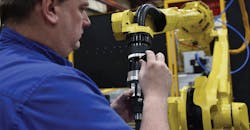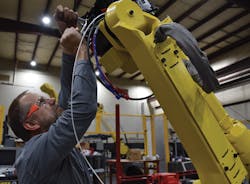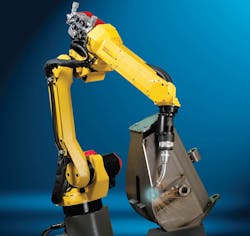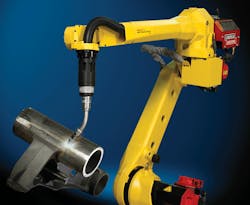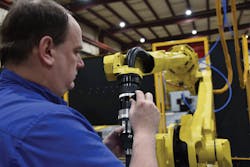Top 10 Welding Trends Fueled by Automation
By PETE ROGERS and NICK COWELL
Acieta LLC
Council Bluffs IA
Improved quality, reduced costs, access to real-time data about equipment and processes are some of the many benefits of robotic automation. The real reason that drives manufacturers to automate, however, is the return on investment (ROI). Two of the most valuable ways to see a quick ROI on automation is to minimize implementation costs and maximize equipment utilization, which are both becoming easier to do with these ten industrial automation trends.
Labor Shortage
According to the American Welding Society, a welder shortage of 291,000 will be in effect in the U.S. by 2020. Combined with increased product demand and competitive pricing, the labor shortage is driving increased interest in robotic welding.
As of 2016, there was an average of 74 industrial robots installed per 10,000 manufacturing employees around the world. In the U.S. specifically, the automotive industry is the fastest growing purchaser of industrial robots, which made up 52 percent of total sales in 2016 — a number which is predicted to grow by at least 15 percent, according to the International Federation of Robotics.
Improved Welding Power Source & Waveform Technology
In the past decade, welding power source technology has improved, offering higher speeds and quality, more throughput and consistency. These advancements are an advantage for companies affected by the skilled labor shortage, as many are looking for ways to increase productivity with fewer employees.
The power source technology means machines are also easier to operate and are specifically designed to help welders of various skill levels to use - saving money on training costs and time. Waveform technology has made it possible to weld applications that were difficult in the past with robotic welding.
Production Monitoring Capabilities
Many manufacturers are choosing production monitoring systems for more accurate yield measurements, increased part quality, and to efficiently manage processes. These systems have given manufacturers a boost with production speed while also monitoring and providing input on the quality of the weld.
This technology has been great for creating optimized processes, setting limits, understanding defects, and managing quality; all of these benefits offer huge time savings to production line managers.
Industrial Internet of Things (IIoT)
As industrial systems, equipment, and regulations evolve rapidly, the need to remain competitive with market technology has increased. The IIoT is making a name for itself in manufacturing by providing accessibility to much more real-time weld quality data and at much more efficient speeds.
IIoT boosts efficiency, scalability, and time savings for industrial companies. Improved safety measures and predictive maintenance data, which provide transparency into company performance, yield cost savings for business owners who adopt IIoT.
Adaptive Welding Advancements
The advancement and addition of sensors for adaptive welding have made robots more user-friendly and also given us greater flexibility and speed when searching and tracking the weld joint. Sensors address a moving weld seam and give the system a sense of touch and sight. As sensors become more aware and able to communicate information rather than just data, we can expect an increased need for sensors by engineers.
Upstream Processes
Upstream practices must be working properly with the weld cell to ensure that the right type and quantity of parts for the welding application are available. Marrying weld cells with upstream processes will save material handling time, floor space, resources, and ensure the operation is flowing smoothly.
Using Six Axis Robots as a Positioner
Industrial automation has seen an increased demand for more flexible part positioning using six-axis robots. These robotic arms have similar capabilities as a human: they rotate, bend, and move in an arc shape. The flexibility of the arm allows the six-axis robot to grip parts at different angles, rotate and tilt parts and generally weld more quickly, consistently and safely. This technology is even making its way to smaller and medium-sized businesses beyond automotive OEMs and larger manufacturers.
Fixtureless Welding
Combining handling robots with welding robots eliminates the need for an operator to load and unload dedicated fixtures used in traditional weld cells. This has resulted in reduced costs and time spent buying, maintaining and storing fixtures. It also helps companies create one piece flow, minimize inventory and work in process for an even bigger ROI. Other benefits include:
• Reduced direct labor cost
• Lights-out operation
• Increased productivity and consistent output
• Improved quality
• Enhanced safety
• Improved working environment
• Creation of new and better jobs
• Reduced/elimination of tooling
• Minimal maintenance
• High part mix and low volumes
With a lack of skilled welders, there has been a strong interest in automation for businesses with demand for high part mix and low volume. Not to mention, unique parts that took days to make can now be done in much less time with automation reducing cost per part and increasing cost savings. While this has been seen overall in the industry, the interest has grown significantly for smaller businesses as a point of entry to automation.
Programming and Operation of Robotic Automation Systems
The advancement of technology has improved the ease-of-use for robotics. Automation systems today offer a more user-friendly interface than older systems. They are also typically easier to program and/or offer offline programming.
However, proper robotic automation training and a deep understanding of the various manufacturing environments will be central to understand the latest technologies. Programmers will need to know the details of sensor technologies, including how they work and how to use them to gather the most relevant data. They’ll also need networking and wireless communications skills to complete any programming efficiently.
The Future of Automation
With the use of robotic welding, there are many opportunities to increase productivity and see significant cost and time savings. If you are considering adopting automated welding, be sure to select an automation integrator that understands these automation trends and the impact they will have on the industry and your business.
Headquartered in Waukesha, WI, Acieta LLC has been specializing in automation technology for 35 years, with over 4,500 robotic system installs across North America. Authors Rogers and Cowell are VP of Operations and Welding Segment Product Manager, respectively.
